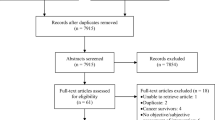Abstract
Little is known on the role of the senses smell and taste in end-of-life care. The presented systematic literature analysis investigates the significance of smell and taste in palliative care. The online databases PubMed, CINAHL, MEDLINE, Deutsche Nationalbibliothek and British National Library were searched for English and German literature published between 1970 and April 2013 containing any kind of original data on the impact of smell and taste in patients in a palliative care situation. All retrieved publications were screened for relevance and full text was obtained for all articles identified as relevant. We integrated 13 papers for further analysis (explorative surveys 5, clinical trials 3, case studies 2, qualitative study 1, brief report 1, clinical report 1). Prevalence of smell and taste alterations in palliative care ranges between 60 and 86 %. Existing literature reflects the significance of smells and tastes in palliative care setting in two main streams—smell and taste alterations as symptoms and malodorous wounds. Prevalence of smell and taste alterations in palliative care is high. However, in palliative care literature concepts for the assessment and fostering of subjective significance of smell and taste and the individual impact of significant smells and tastes are predominantly neglected. Available instruments should be characterized, validated and adapted for the use for palliative care patients.


Similar content being viewed by others
References
Alt-Epping B, Nejad RK, Jung K et al (2012) Symptoms of the oral cavity and their association with local microbiological and clinical findings—a prospective survey in palliative care. Support Care Cancer 20:531–537
Boyce JM, Shone GR (2006) Effects of aging on smell and taste. Postgrad Med J 82:239–241
Brisbois TD, De Kock IH, Watanabe SM et al (2011) Characterization of chemosensory alterations in advanced cancer reveals specific chemosensory phenotypes impacting dietary intake and quality of life. J Pain Symptom Manag 41:673–683
Brisbois TD, De Kock IH, Watanabe SM et al (2011) Delta-9-tetrahydrocannabinol may palliate altered chemosensory perception in cancer patients: results of a randomized, double-blind, placebo-controlled pilot trial. Ann Oncol 22:2086–2093
Brisbois TD, Hutton JL, Baracos VE et al (2006) Taste and smell abnormalities as an independent cause of failure of food intake in patients with advanced cancer—an argument for the application of sensory science. J Palliat Care 22:111–114
Croy I, Buschhüter D, Seo H et al (2010) Individual significance of olfaction: development of a questionnaire. Eur Arch Otorhinolaryngol Head Neck 267:67–71
Dewys WD, Walters K (1975) Abnormalities of taste sensation in cancer patients. Cancer 36:1888–1896
Gethin G (2011) Management of malodour in palliative wound care. Br J Commun Nurs 16:6
Hatt H (2007) Geschmack und Geruch. In: Schmidt RF, Lang F (eds) Physiologie des Menschen. Springer Medizin Verlag Heidelberg, Berlin, Heidelberg, pp 422–436
Heckel M, Rester D, Seeberger B (2012) Und den Geschmack habe ich heute auch noch auf der Zunge. Geruch und Geschmack im Lebensverlauf—Ein qualitatives Experiment. Forum Qual Sozialforschung 13:art. 3
Heilmann S, Strehle G, Rosenheim K et al (2002) Clinical assessment of retronasal olfactory function. Arch Otolaryngol Head Neck Surg 128:414–418
Hummel T, Landis BN, Huttenbrink KB (2011) Smell and taste disorders. GMS Curr Top Otorhinolaryngol Head Neck Surg 10:doc04
Hutton JL, Baracos VE, Wismer WV (2007) Chemosensory dysfunction is a primary factor in the evolution of declining nutritional status and quality of life in patients with advanced cancer. J Pain Symptom Manag 33:156–165
Mahmoud FA, Aktas A, Walsh D et al (2011) A pilot study of taste changes among hospice inpatients with advanced cancer. Am J Hosp Palliat Care 28:487–492
Morris C (2008) Wound odour: principles of management and the use of ClinicSorb. Br J Nurs 17(6):38–42
Murphy C, Schubert CR, Cruickshanks KJ et al (2002) Prevalence of olfactory impairment in older adults. J Am Med Assoc (JAMA) 288:2307–2312
Pattison R (1999) Alteration in taste perception and its relationship with nutritional status and quality of life in patients with advanced cancer. Queen Margaret University College, Edinburgh, UK
Rehwaldt M, Wickham R, Purl S et al (2009) Self-care strategies to cope with taste changes after chemotherapy. Oncol Nurs Forum 36:E47–E56
Schiffman SS (2007) Critical illness and changes in sensory perception. Proc Nutr Soc 66:331–345
Schriever VA, Lehmann S, Prange J et al (2014) Preventing olfactory deterioration: olfactory training may be of help in older people. J Am Geriatr Soc 62:384–386
West D (2007) A palliative approach to the management of malodour from malignant fungating tumours. Int J Palliat Nurs 13:137–142
Wilkes LM, Boxer E, White K (2003) The hidden side of nursing: why caring for patients with malignant malodorous wounds is so difficult. J Wound Care 12:76–80
Wismer WV (2008) Assessing alterations in taste and their impact on cancer care. Curr Opin Support Palliat Care 2:282–287
Yakirevitch A, Bercovici M, Migirov L et al (2006) Olfactory function in oncologic hospice patients. J Palliat Med 9:57–60
Acknowledgments
This research received no specific grant from any funding agency in the public, commercial, or not-for-profit sectors.
Conflict of interest
The authors have no conflict of interests to declare.
Author information
Authors and Affiliations
Corresponding author
Rights and permissions
About this article
Cite this article
Heckel, M., Stiel, S. & Ostgathe, C. Smell and taste in palliative care: a systematic analysis of literature. Eur Arch Otorhinolaryngol 272, 279–288 (2015). https://doi.org/10.1007/s00405-014-3016-4
Received:
Accepted:
Published:
Issue Date:
DOI: https://doi.org/10.1007/s00405-014-3016-4




